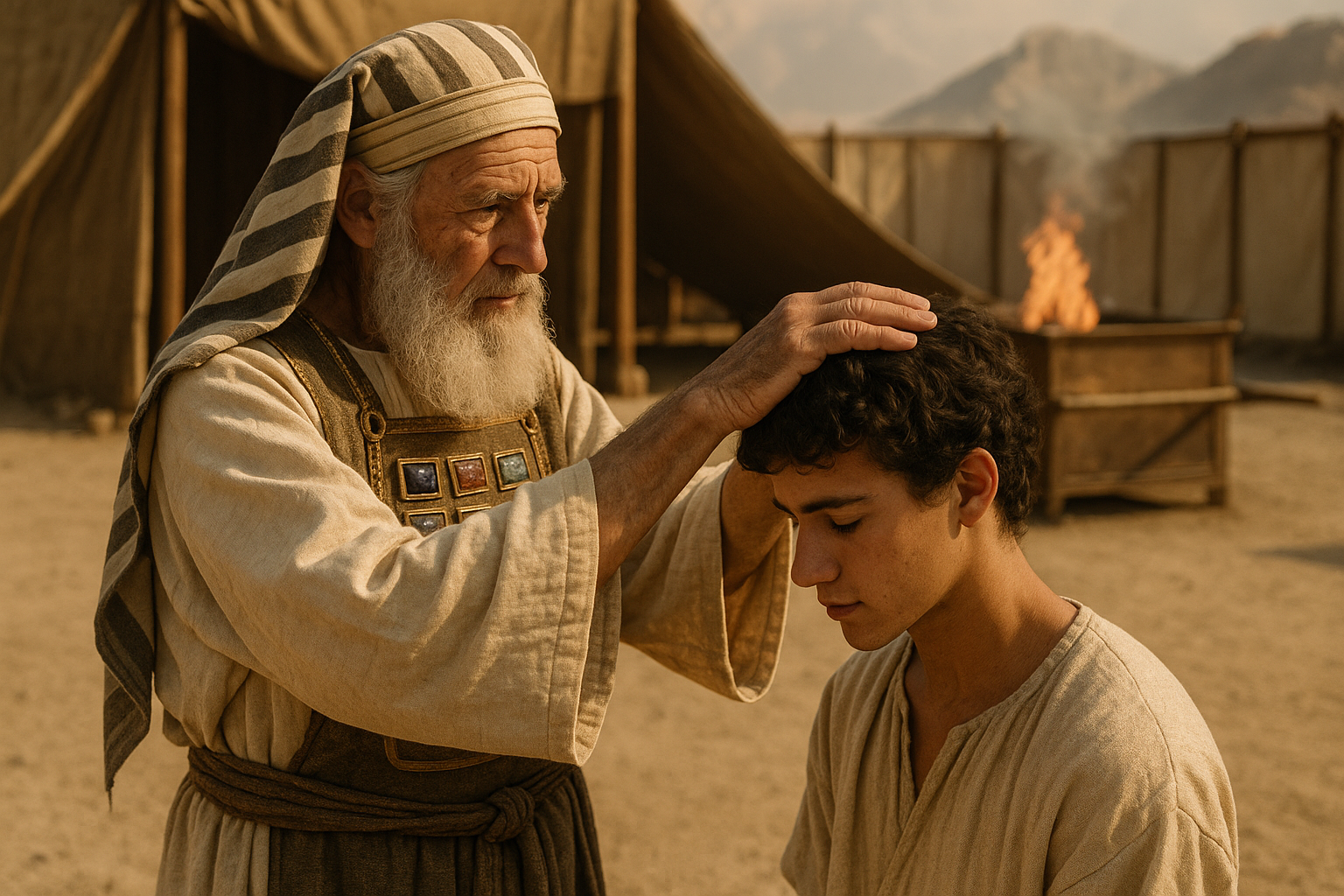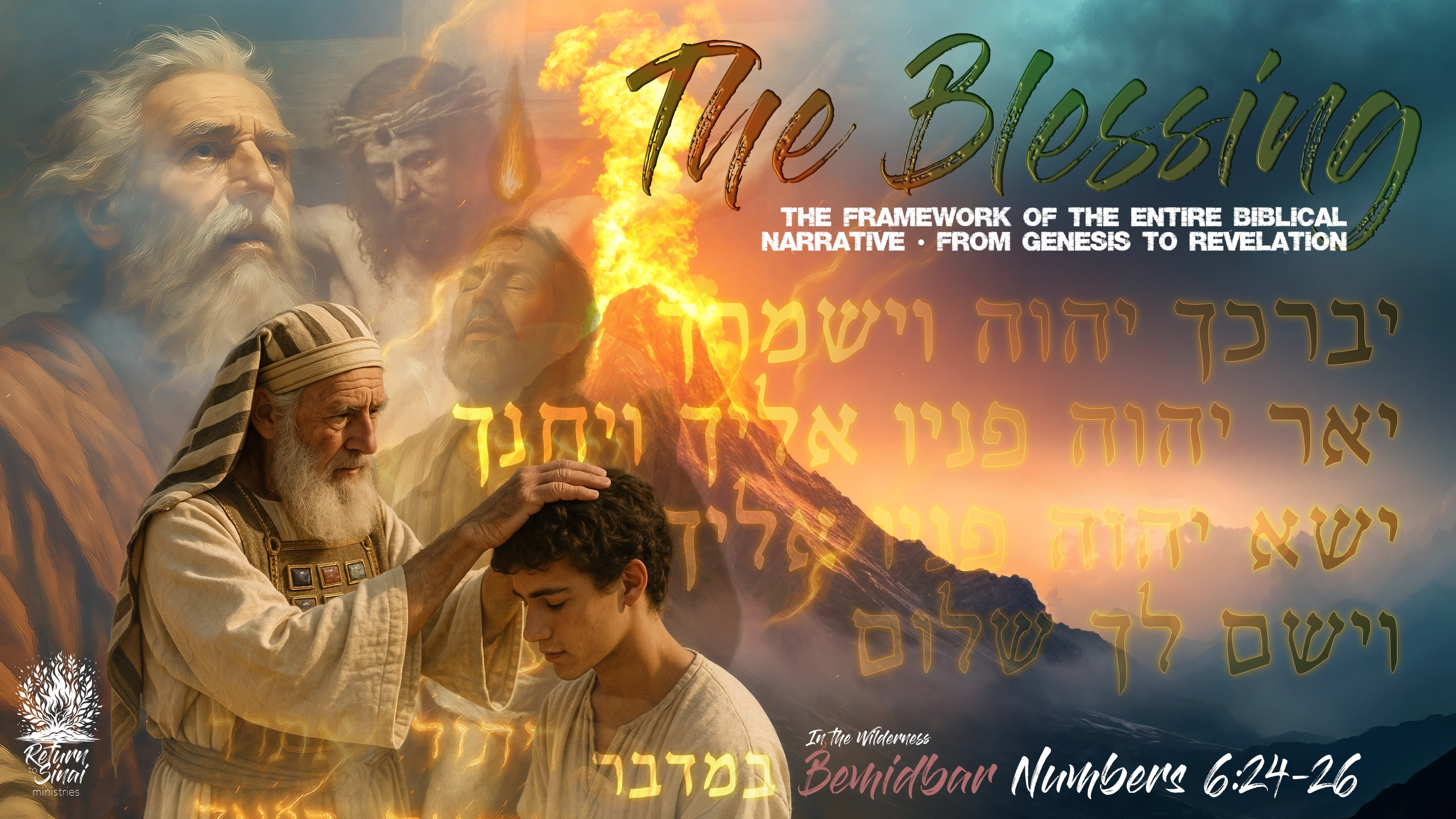THE FRAMEWORK OF THE ENTIRE BIBLICAL NARRATIVE FROM GENESIS TO REVELATION.
From Genesis to Revelation, the Aaronic Blessing, also known as the priestly blessing, encapsulates Yahweh’s relationship with His people, weaving together themes of divine favor, revelation, and ultimate restoration. Spoken by Yahweh Himself and entrusted to Aaron and his descendants, this blessing is not merely a prayer—it is a declaration of Yahweh’s faithfulness, reflecting His redemptive plan throughout history.
The Text of the Blessing
(Numbers 6:24-26)
יברכך יהוה וישמרך יאר יהוה פניו אליך ויחנך ישא יהוה פניו אליך וישם לך שלום

Translation
“May Yahweh bless you and keep you. May Yahweh make His face shine upon you and show you favor. May Yahweh lift up His face toward you and give you peace.”
This blessing does not stand alone—it mirrors the entire arc of Scripture, tracing Yahweh’s covenant with Abraham, His revelation at Sinai, and culminating in the redemptive work of Yeshua.
For God so loved the world, that He gave His only begotten Son, that whoever believes in Him shall not perish, but have eternal life.
John 3:16 • Legacy Standard Bible (LSB)
A Threefold Pattern: Blessing, Favor, Restoration.
1. Yahweh Blesses Abraham (יברכך יהוה – “May Yahweh bless you”)
The verb ברך (barach) conveys divine favor, prosperity, and multiplication. This directly connects to Genesis 12:2-3, where Yahweh blesses Abraham, saying: “I will bless you… and in you all the families of the earth will be blessed.”
Yahweh’s intentions have always been to bless all of creation. By blessing Abraham with a restored perspective reminiscent of the Garden of Eden, the process of reconciliation was set in motion. This is not a new vision but a new approach—one that allows us to return to the very beginning, to undo what Adam did. It offers us the opportunity to choose life once again, rather than relying on our own interpretations of good and evil. Through the nations that descend from Abraham, we are meant to demonstrate how magnificent the world could have been if Adam had succeeded in fulfilling his divine purpose.
Yahweh wants to bless us with His beautiful creation, reconciling us to Him, restoring our relationship we had with Him in the Garden. By trusting in His blessing and protection, and above all, on His perspective of “good” and “evil”, on His terms, not ours.
This theme extends through history, reaching fulfillment in Yeshua, through whom the promise of divine blessing extends to all who enter into covenant with Him.
Talmudic Reference:
- Mishnah Berakhot 9:5 – Teaches that one should bless Yahweh for both the good and the bad in life, recognizing that all things work within His divine plan. This reinforces the trust required to receive Yahweh’s blessing, as seen in Abraham’s covenantal journey.1
2. Yahweh’s Face Shines at Sinai (יאר יהוה פניו אליך – “May Yahweh shine His face upon you”)
The verb אור (or) means light, illumination, or revelation. When Yahweh descended upon Mount Sinai, His presence was visibly revealed through fire and thunder (Exodus 19). This moment was pivotal—the giving of the Torah, the shining of divine revelation upon Israel.
This all started at Genesis 1. All the symbols of the state of Creation are very interesting to me. The breathtaking thought that everything comes to existence by the Word of Yahweh, and then organized by the council of the Spirit is breathtaking indeed, But of course this begs the question?
Why the Earth was void and empty in the first place? The implications bring many more questions. Why Yahweh created everything in such state of chaos? Why not bringing order at first request? The answer to this questions is not a simple agnostic complaint or a systematic atheistic mockery. And the answers are revealed throughout Scripture.
And of course this, as a believer of Yahweh, will make you associate the conversation to a very famous Psalm, and the longest Psalm ever written, Psalm 119.
Your word is a lamp to my feet And a light to my path.
Psalm 119:105 • Legacy Standard Bible (LSB)
The Word of Yahweh is a lamp, a light, a guiding light to be exact. The implications are immense, and yet again, light becomes an important aspect of Yahweh’s relational personality with creation. And by now you might even answer the questions by yourself if you’re allowing His Spirit to guide you.
Yahweh does not want a creation like a painting that you make one time and hang it on the wall, but still looks like a masterpiece. Or an AI service that can be easily manipulated by programmers, including robots, but still creation is guided by the laws of physics that has endured millennia. No, Yahweh wants a creation that relates and voluntarily seek Him.
And not just seek Him, but obeys and loves Him.
This same theme continues with Yeshua, who is called “the light of the world” (John 8:12). Just as Sinai illuminated Israel’s covenant, Yeshua illuminates the hearts of those who walk in His ways.
Historical Reference:
- Ketef Hinnom Silver Scrolls (7th Century BCE) – The Aaronic Blessing was found inscribed on silver amulets in Jerusalem. This discovery confirms its early liturgical use and the enduring significance of Yahweh’s shining presence among His people.2

3. Yahweh Lifts Up His Countenance in Redemption (ישא יהוה פניו אליך – “May Yahweh lift His face toward you”)
The root נשא (nasa) means to lift up, carry, exalt, or forgive. This imagery paints a picture of a father lifting his child, gazing upon him with love and delight. This aligns with Psalm 103:13: “As a father shows compassion to his children, so Yahweh shows compassion to those who fear Him.”
This finds its fullest expression in Yeshua’s work of redemption—humanity, once separated, is lifted up into divine favor through faith.
A more clear picture or example was portrayed by Yeshua, to His close circle of friends first, when He got down His knees to wash their stinky feet’s during the Passover meal. But He was brought down to the worst of sinners, on the cross. Like the rock tablets crafted by Yahweh’s hand and destroyed by our transgressions. Literally breaking all the law at once. Still Moses found favor from Yahweh. He call Moses His friend who He speaks face to face.
Yeshua got down to His knees to give us life. He lift up His countenance towards us and said:
“Father, forgive them; for they do not know what they are doing.”
Luke 23:34 • Legacy Standard Bible (LSB)
Talmudic Reference:
- Sefer HaChinukh – Explains that when one recites a blessing, they are acknowledging Yahweh’s sovereignty and goodness. The lifting of Yahweh’s countenance in the Aaronic Blessing symbolizes reconciliation and spiritual restoration.3
Faith in the Wilderness: The Gospel Message.
A key aspect of this blessing is its wilderness setting. The wilderness was a place of testing, where Israel had to learn faith in Yahweh’s promises. This mirrors the entire gospel message—trusting Yahweh’s blessing through Yeshua, not through blind faith, but based on His proven works throughout history.
- Blessing in the Wilderness → Israel received Yahweh’s favor and protection in a barren land. They had no resources of their own—their survival depended entirely on Him.
- Faith Rooted in Yahweh’s Past Works → Yahweh constantly calls His people to remember—the Exodus, His miracles, His covenant with Abraham—all evidence of His faithfulness in history. This forms the foundation for trusting His future promises.
- The Gospel in the Wilderness → Yeshua spent 40 days in the wilderness, resisting temptation and demonstrating complete dependence on Yahweh. Israel, too, had to learn trust in the wilderness, realizing that their provision and victory came solely from Yahweh.
Talmudic Reference:
- Hirsch’s Commentary on the Priestly Blessing – Notes that the priest raises his hands vertically to heaven while reciting the blessing, emphasizing that it comes directly from Yahweh. This reflects the wilderness experience—Israel had to look upward in dependence upon Yahweh’s provision and promises.4
Conclusion: The Blessing as the Biblical Narrative.
The Aaronic Blessing is not just a closing prayer—it is the summary of Scripture itself:
- Blessing (Abraham’s covenant) → Favor (Illumination / Revelation) (Sinai revelation) → Restoration (Yeshua’s redemption).
Faith stands on Yahweh’s faithfulness, knowing that what He has already fulfilled assures us that all His promises will be accomplished.
This blessing, given in the wilderness, is our assurance that Yahweh is faithful, and His redemptive plan is secure.
Resources
- Mishnah Berakhot 9:5 ↩︎
- Ketef Hinnom Silver Scrolls (7th Century BCE) ↩︎
- Sefer HaChinukh ↩︎
- Hirsch’s Commentary on the Priestly Blessing ↩︎
Historical & Archaeological References
- Ketef Hinnom Silver Scrolls – Ancient Hebrew amulets with the Aaronic Blessing, confirming its early liturgical use. See it here
Talmudic & Rabbinic Insights
- Sefer HaChinukh – Explanation of blessings and their connection to Yahweh’s sovereignty. See more information here.
- Mishnah Berakhot 9:5 – Teaching on blessing Yahweh for both good and challenging circumstances. More information here.
- Hirsch’s Commentary on the Priestly Blessing – A detailed analysis on the priestly blessing structure. More here.

Leave a Reply